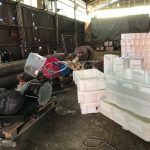20161115
My text for Esitys mag. is out: Uusmaterialistista yhdyntää (2016). The online version of the mag also features an insightful text from Pilvi: Jumalattaria vai sarjamurhaajia?, which looks at how masturbation has been represented on stages.
Masha Gessen details how to survive autocracy in the USA. The same logic applies to today’s politics in Finland under the “True Finns” thumb.
- Believe the autocrat [If he says that he’s gonna – He will].
- Do not be taken in by small signs of normality [If things look like they are staying the same it doesn’t mean they are].
- Institutions will not save you [There are no neutral public institutions. They are managed by the government].
- Be outraged [If you stop resisting they will silence you).
- Don’t make compromises [If you negotiate you legitimise their reign].
- Remember the future [The outcome of events can be affected].
“… when Marx wondered about what would happen if commodities could speak, he might as well have asked slaves, or the Haitian revolutionaries.” writes María Iñigo Clavo in Modernity vs. Epistemodiversity on e-flux (as recommended by Jussi). The arrival of the text is well timed as we just finished a grant proposal together with Eleonora Lundell. We are seeking funds for a talk-shop, where people who have settled to Helsinki would talk about objects they hold dear.
20160622
Jussi Koitela send me two texts to ponder. “Self branding anarchist…” (In Finnish) looks at how self-employed political activists and creatives fit to the new-work ethos. The text attempts to update the critique of new-work. But other then looking at how social media serves the demands of new-work, the text fails in providing new insight on the matter. I think Tero Nauha’s old article “Pickpocketer or Politician” (In Finnish) is still more successful in building awareness. A recent text by Janne Saarakkala also covers issues well (In Finnish).
The “Self branding anarchist..” looks at the case of self proclaimed “anarchist on watch” Suvi Auvinen and analyses her status as a new-worker, primarily through her presence in social media. She is an outspoken anarchist and has used media to create awareness for projects she’s been involved with. Through this exposure she has gained nationwide recognition as an political intellectual, who can be consulted on any issue. The text argues that she is actually a tool for ideologies advocating self-employment and that she has made her political efforts vain by popularising them. The argument is that anarchistic practices cannot remain autonomous in corporate controlled social medias.
That argument is as silly as claiming that critical thinking could not manifest as text.
The critique is unfair to Auvinen and fails to see her as a precariat object conforming to the pressures of new-work conditions. She is an antagonist whose struggle for autonomy we are witnessing and learning from. I see her as an accelerationist and her relation to mainstream media as an effort to implode its exploitative nature. She already has broader audience than the old leftist People’s News magazine which published the critique.
I’m not her fan. I think her presence in social medias was irritating. She was fast to react to news but her responses were fuelled by feel-good-hype and her update pace was breathtaking. I do feel that her efforts in making anarchism know do more good than harm. I got to know her 2011 when I was visiting the Jokikatu squat (More on Jokikatu in the waybackmachine archive in Finnish) when there were plans to make Turku the “Subculture Capital of Europe 2011”.
The other text Koitela send me was “The Artist-in-Consultance: Welcome to the New Management“. The article by Elvia Wilk recaps how different artist-in-residency programs for corporations have been organized through the years. The text gives a short introduction to organisations like the late Artist Placement Group and tries to understand why big companies (like FB or Google) are keen in inviting artists to work with them. The reasoning is that through the artist’s body and by witnessing her/his struggle, the workers of the corporations get to experience freedom and can align themselves with creative culture (I have personal experience of this as a worker of the Kone Corporation approached me after I got a grant from the Kone Foundation. We exchanged some messages and it was fun).
Andrew Norman Wilson tells a completely different story about artistic practice in the corporate sphere.
Wilk text presents artists as particularly fitting workers to serve big businesses desire for innovation and their aim to revolutionize life through their designs. Wilks argues that artist&corporation collaborations a fact of life as artist cannot escape monetary economics. Instead of wasting energy to fight for the autonomy in arts, the text tries to set a new angle for corporate collaborations. The audience (and judge) of artistic practices that develop in partnerships with corporations, should be the ecological well being of the planet. The text also sets a tactical guideline for these collaborations: “The goal of the artist-in-consultance should not be to force the interests of business, art, and the planet to overlap, but to preserve their misalignment at all costs.”.
Edit: Made a song about my-new-work.
20160610
In the Finnish art yargon artist are always portrayed as underdogs of contemporary society. This status requires critical reassessment. By claiming an underdog status artists exclude themselves from the responsibility of developing more sustainable systems. I think artist are very powerful and their work has an impact in the city. Losing the underdog status will force us to make claims about the world and open our practices up for critique. We can do this together, so let’s agree on something.
Visited the Sorbus crew exhibition at SIC with Pietari. The audience of the exhibition was a positive mix of elderly folk and kids. The group presented a 30min movie which was a celebration and critique of contemporary yuppie culture. The artwork showed how a group of entrepreneurs search for inspiration from urban countercultures and utilize anti-authoritarian, horizontal organizational strategies for their personal economic gain. The movie was a subvertisement which kept the audience hooked with splatter movie tricks and clean cinematography. I enjoyed the exhibition and the afterparty.
The movie felt like a response to recent critique of Sorbus and SIC, which states that these organization (funded by the Kone foundation and Kulttuurirahasto) inadvertently advance economically liberal values and partake in gentrification processes of developing city areas. The critique presents these organizations as youthful lubrication for liberal city development (Much like the Restaurant days and other startup incubators). Jussi Koitela’s text also portrays these organizations as undemocratic and non-transparent. I think the non-transparency part is true.. I really don’t know how Sorbus or SIC curate their events. I don’t know how to befriend them or even where to meet them.
The way they function is very different from the way the older, national artist union associated art spaces are organized. These organizations elect members by voting and board members can have an significant impact in the direction the associations takes. Unfortunately the Muu Association (which serves performance and media-artists) feels corrupted as it has been run by the same small inner circle for years. But in theory I could join the ranks and work for change inside the system. I would have a better opportunity impacting the Finnish (and European) art scene through Muu Association then I have through any other artist run platform in the world!
What’s keeping me from joining the association? The 70€ yearly union fee? After paying the fee I would be entitled to legal council from the national artist association lawyers and various other benefits (like discounts from local arts and craft shops). Paying the fee would give the opportunity to expand my practice. 70€ cannot be the reason. I guess it comes down to the feel of the organization. Muu Association feels like it belongs to a different era. It feels old.
This debate resembles critique concerning the DIS collective. The question is that can artists appropriate entrepreneurial start-up business strategies (tactical media, sponsored beer & sex) for changing the world and still stay true to their cause. I think that the Burning Man festival commodification process is clear evidence that organizations which fail to establish themselves financially will be squatted by corporations. To remain independent artist organisations need to accumulate their own capital. I think union fees is the best way for doing this. After enough capital is accumulated it could be used to acquire property and to use it to benefit the community. Exhibition in this space would advance communism through an acutely curated program of events and publications. I’d call the space “International Muusicbus Space 2.0”.



















